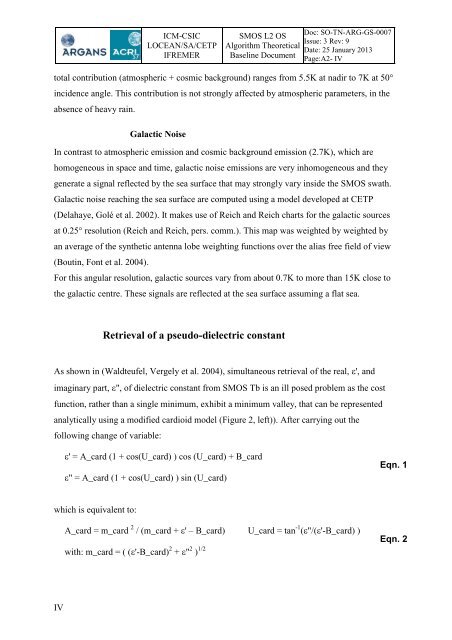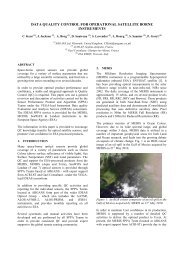SMOS L2 OS ATBD - ARGANS
SMOS L2 OS ATBD - ARGANS
SMOS L2 OS ATBD - ARGANS
You also want an ePaper? Increase the reach of your titles
YUMPU automatically turns print PDFs into web optimized ePapers that Google loves.
IV<br />
ICM-CSIC<br />
LOCEAN/SA/CETP<br />
IFREMER<br />
<strong>SM<strong>OS</strong></strong> <strong>L2</strong> <strong>OS</strong><br />
Algorithm Theoretical<br />
Baseline Document<br />
Doc: SO-TN-ARG-GS-0007<br />
Issue: 3 Rev: 9<br />
Date: 25 January 2013<br />
Page:A2- IV<br />
total contribution (atmospheric + cosmic background) ranges from 5.5K at nadir to 7K at 50°<br />
incidence angle. This contribution is not strongly affected by atmospheric parameters, in the<br />
absence of heavy rain.<br />
Galactic Noise<br />
In contrast to atmospheric emission and cosmic background emission (2.7K), which are<br />
homogeneous in space and time, galactic noise emissions are very inhomogeneous and they<br />
generate a signal reflected by the sea surface that may strongly vary inside the <strong>SM<strong>OS</strong></strong> swath.<br />
Galactic noise reaching the sea surface are computed using a model developed at CETP<br />
(Delahaye, Golé et al. 2002). It makes use of Reich and Reich charts for the galactic sources<br />
at 0.25° resolution (Reich and Reich, pers. comm.). This map was weighted by weighted by<br />
an average of the synthetic antenna lobe weighting functions over the alias free field of view<br />
(Boutin, Font et al. 2004).<br />
For this angular resolution, galactic sources vary from about 0.7K to more than 15K close to<br />
the galactic centre. These signals are reflected at the sea surface assuming a flat sea.<br />
Retrieval of a pseudo-dielectric constant<br />
As shown in (Waldteufel, Vergely et al. 2004), simultaneous retrieval of the real, ', and<br />
imaginary part, ", of dielectric constant from <strong>SM<strong>OS</strong></strong> Tb is an ill posed problem as the cost<br />
function, rather than a single minimum, exhibit a minimum valley, that can be represented<br />
analytically using a modified cardioid model (Figure 2, left)). After carrying out the<br />
following change of variable:<br />
' = A_card (1 + cos(U_card) ) cos (U_card) + B_card<br />
" = A_card (1 + cos(U_card) ) sin (U_card)<br />
which is equivalent to:<br />
A_card = m_card 2 / (m_card + ' – B_card) U_card = tan -1 ("/('-B_card) )<br />
with: m_card = ( ('-B_card) 2 + " 2 ) 1/2<br />
Eqn. 1<br />
Eqn. 2



